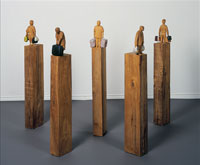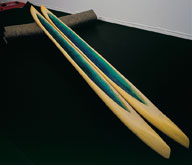Mimi Cho
Former Assistant Curator I (Modern Art), Hong Kong Museum of Art
2008
 Fung Lik-yan (1964 - ) Baggage 2005 |
 Lam Laam (1973 - ) To someone who wants to cry 2003 |
The history of art abounds in stimulating works that arouse the viewer's deepest emotional responses. Lu Xun, the father of modern Chinese literature, once said, "Creations always find their roots in love." The form of a work's artistic expression is strongly linked to the inner feelings of its creator, and when a viewer comes into contact with that expression, intricate, complex interconnections are made and meaningful interpretations subsequently produced.
Lam Laam's To someone who wants to cry is formed by two canoes lying quietly side by side. The wooden vessels, in the shape of two chrysanthemum petals, are not floating on water. Instead, water is contained in the hollow spaces of the canoes, perhaps in resemblance of running tears. The far ends of the two canoes are raised and rested on a roll of felt in a way that reminds us of the use of this material by the German post-war artist Joseph Beuys (1921-1986) to symbolize warmth and healing.
Baggage by Fung Lik-yan contains five little painted wooden figures reminiscent of the form of statues of heroes that can be found in public squares. The figures represent ordinary yet real characters that inhabit the metropolis: a taxi driver lifts the heavy luggage of his passenger; a mother carries her child's school bag on the way to school; an office clerk buys daily necessities from the supermarket after work; a hotel porter holds lots of shopping bags for a guest; and a man pulls heavy red-white-blue bags with different goods in them to and fro across the China-Hong Kong border to scrape a living. Most of the "baggage" these people are carrying, however, does not belong to them.
Both these young artists have chosen wood as the material for their works. Its weighty, natural and organic properties are well suited for the aim of reaching out for intimate communications. The artistic inspirations come from living in the real world. Driven by truthfulness, the artists' messages are conveyed through the artistic forms, connecting with viewers from different backgrounds and experiences of life and producing a heartfelt impact, a release or an empathetic smile on the part of the beholder. It is this emotional connection that is perhaps the most valuable and interesting aspect of art.



